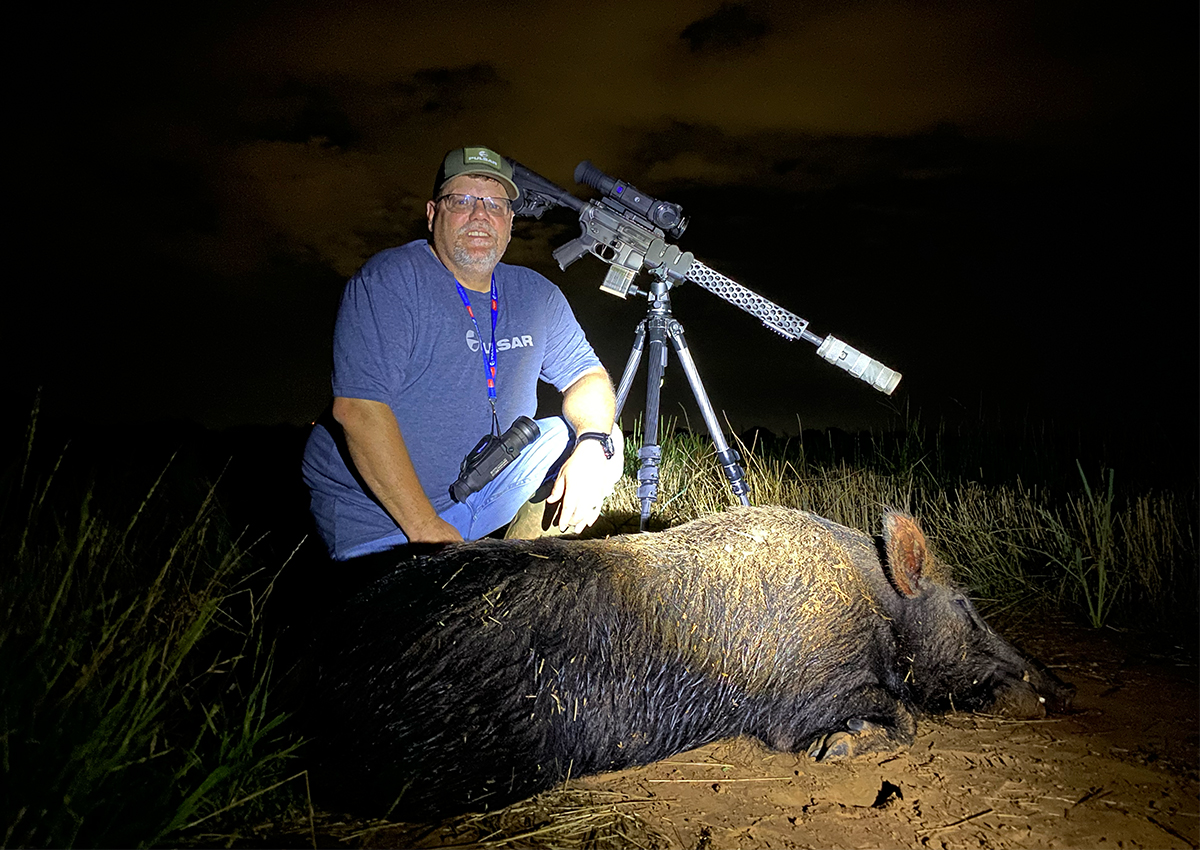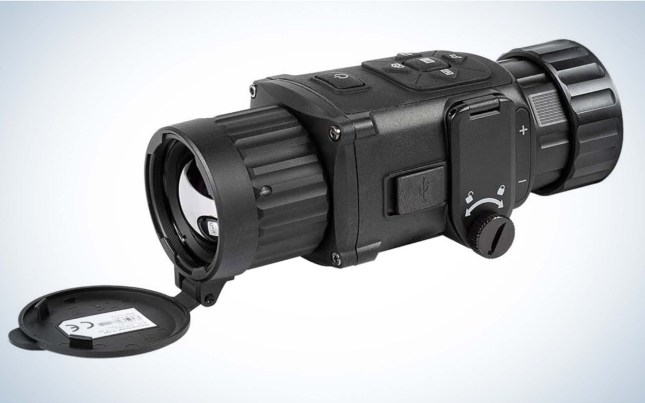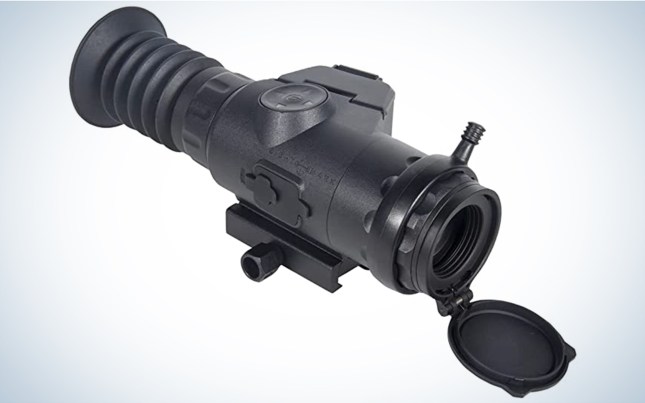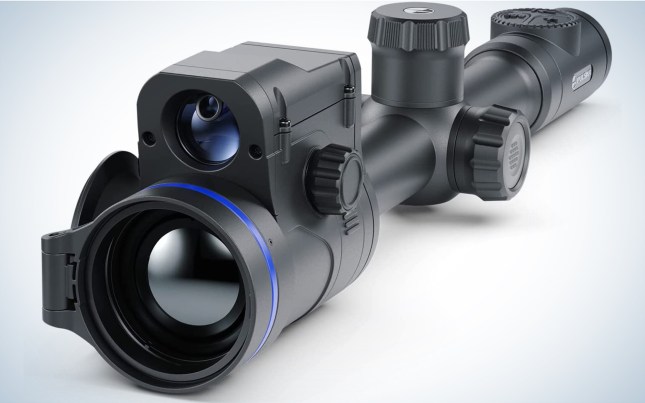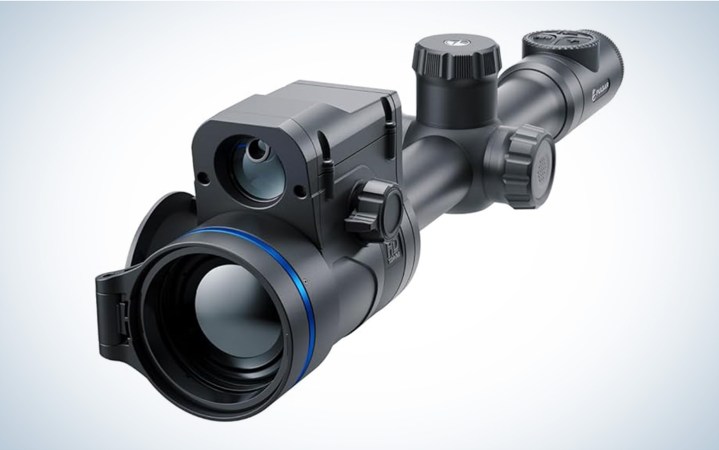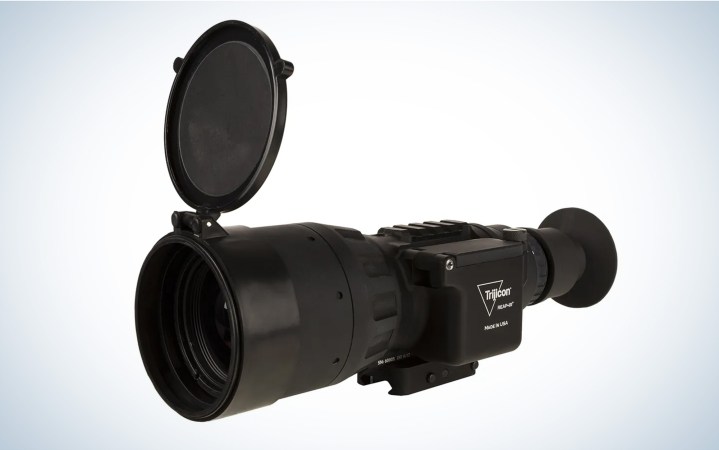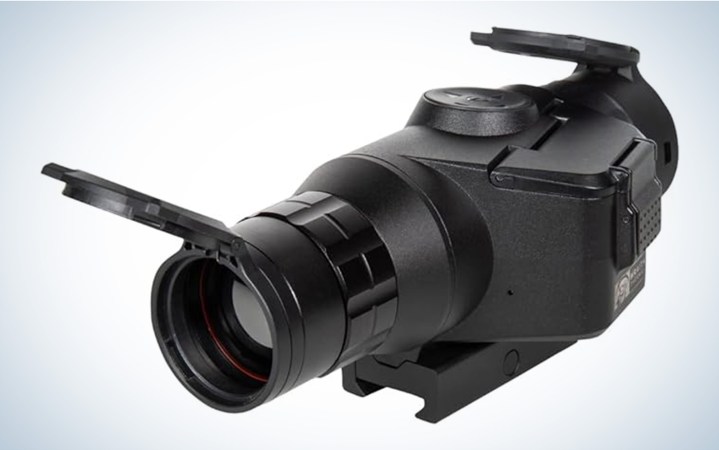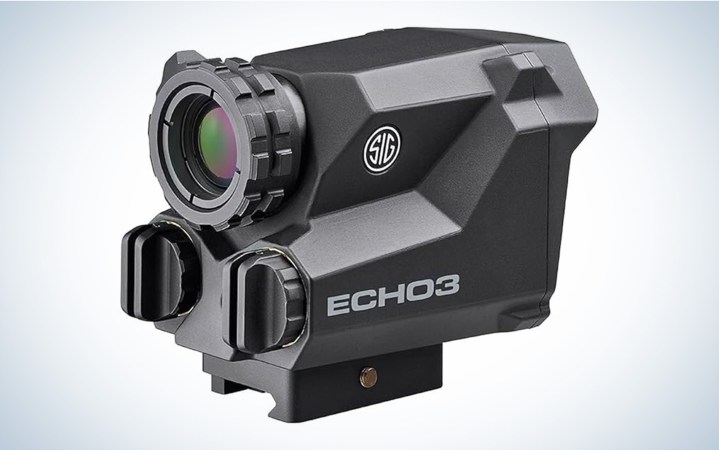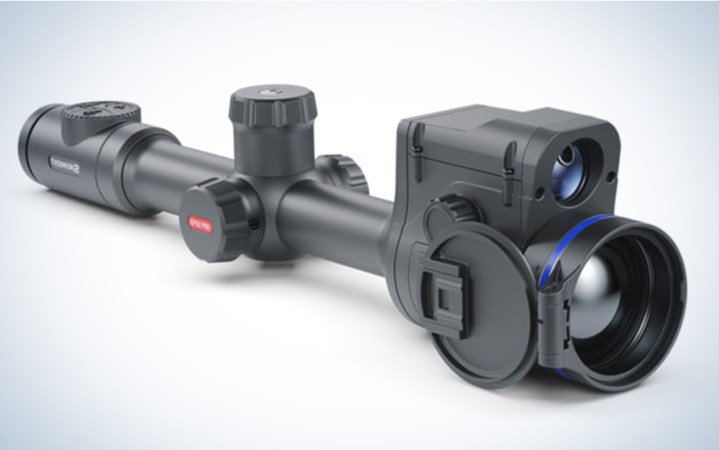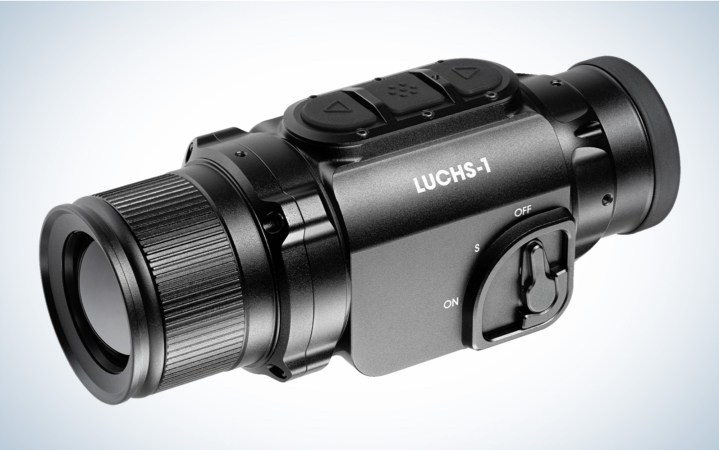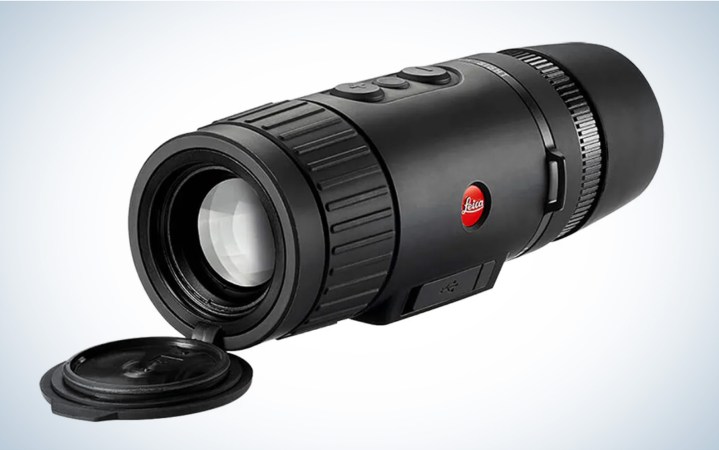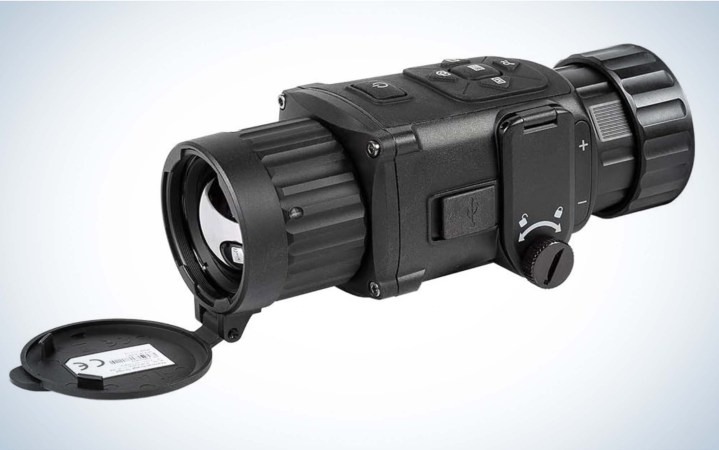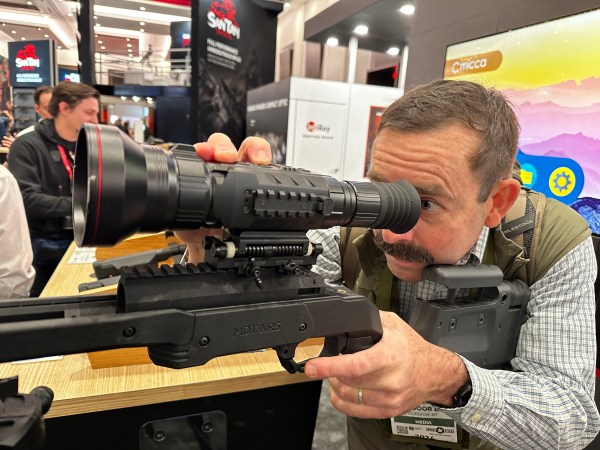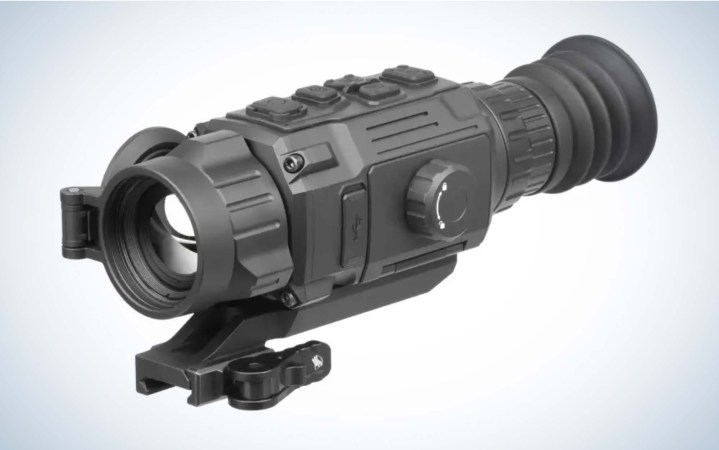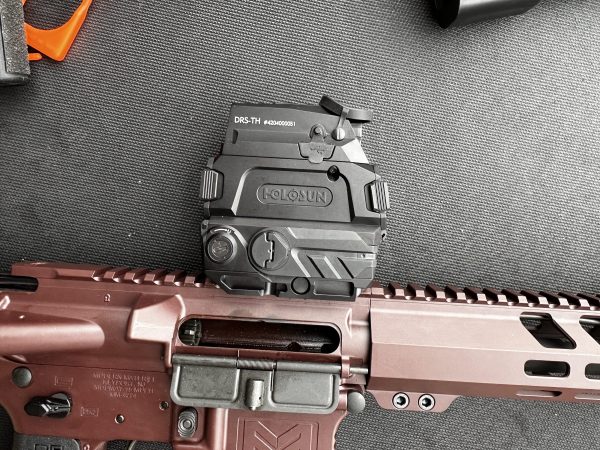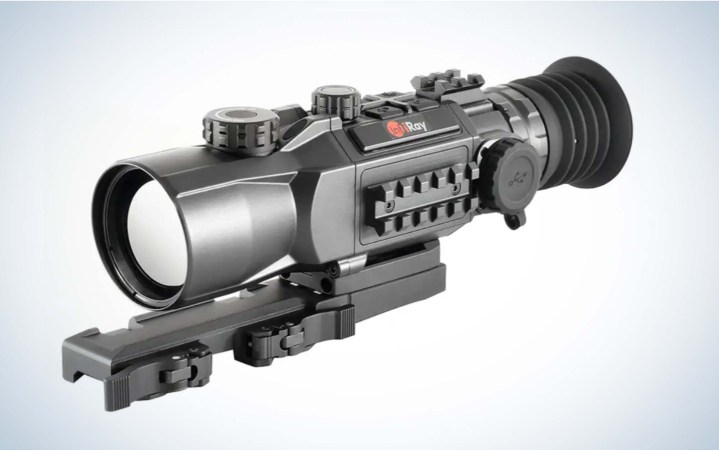We may earn revenue from the products available on this page and participate in affiliate programs. Learn More ›
Thermal scopes don’t just level the playing field; they tip the field decidedly in your favor. That’s the main reason why they’re prohibited for most hunting. But for animals like coyotes and feral hogs in many states, they’re legal and an unequaled aid.
It’s a category in the process of rapid evolution. New models have on-board rangefinders, high-definition video and still photo capability, and even Bluetooth connections to mobile apps. Even better, the price for many of these units has fallen to a level where they’re more affordable.
To help you sort through the options, I’ve been testing a selection of the best thermal scopes, with the help of a friend, while hunting coyotes this winter. Note that these are products we’ve had in our hands, on our rifles, and in the field. There’s a whole new crop of thermal scopes that are coming to market in the next few months, and we’ll follow this up with a review of brand-new thermal scopes later in the year, once we get them in our hands. (There’s a preview of those new models at the end of the review.) Until then, here are my picks for the best thermal scopes.
Topics and Products Covered
- Best Overall: Pulsar Thermion 2 LRF XL50
- Best Large-Caliber Thermal Rifle Scope: Trijicon REAP-IR 60
- Best Entry-Level Thermal Scope: Sightmark Wraith Mini Thermal
- Best AR Thermal Sight: Sig Echo3
- Best Clip-On: Liemke Luchs-1
- Best Image: Leica Calonox Sight
- Best Value Clip On: AGM Rattler TC35-384 Thermal Clip-On
Things to Consider Before Buying a Thermal Scope
How We Tested the Best Thermal Scopes

There’s really no substitute for field time with thermal scopes. You can read their specifications and compare attributes without handling the units, but reading about digital resolution or video-recording capabilities can’t measure how long the batteries last in a cold winter night on the prairie, or how precise a built-in laser rangefinder is at ranging targets in the dark, or how easy the controls are to manipulate while wearing gloves.
Our test is designed to compare and contrast the specs of each submission, but then determine how they perform in the field. My assistant, coyote-hunting addict Kaden Fossum, and I spent several months with these units during the winter in eastern Montana. We took each thermal scope on a series of coyote hunts, where we each recorded our activities, often literally, with the on-board image- and video-recording capabilities of each unit. We compared their display resolution, thermal sensitivity, and ease of use. But we also rated each unit’s “shootability,” or talent in making a shot in the hectic environment of the field, often in extreme cold, sometimes when a coyote approached a blind spot, or often making a follow-up shot after a first shot missed its mark.
Unlike Outdoor Life’s optics test, in which each attribute is assigned a specific numeric score and overall point totals determine each optic’s place within the field, Fossum and I compared notes of the thermals to arrive at conclusions and rankings. It’s less analytic than impressionistic, but that suits the category, since so many performance attributes of thermals are defined by technical specs. A thermal with a sensor resolution of 640×480 and a 1024×768 display is going to look like the next thermal, from another brand, with the same specs. Same with color palettes, which are pretty much identical from model to model.
Instead of measuring spec-driven performance, Fossum and I rated each unit on these criteria:
- Ease of set-up: Mounting, zeroing, and reticle adjustment
- Connectivity: Interface with mobile app, ability to connect to Bluetooth and Wi-Fi, ability to customize ballistic inputs, and image capture and sharing
- Thermal Performance: Refresh rate, number and variety of color palettes, detection distance, contrast, and both daytime and nighttime visibility
- Shootability: Button ergonomics, eye relief, magnification, and features like picture-in-picture displays, and rangefinding
- Field-Worthiness: Durability, battery life, and versatility
- Price Value: An assessment of how much instrument you get for your money
After assessing all these inputs, we determine if a thermal sight is especially well-suited for a particular activity, and give it a “Best For…” citation in order to help readers determine which unit is the best for their particular pursuit and budget.
Best Thermal Scopes: Reviews & Recommendations
Best Overall: Pulsar Thermion 2 LRF XL50
Score Card
- Ease of Set-Up: Very Good
- Connectivity: Very Good
- Thermal Performance: Excellent
- Shootability: Very Good
- Field-Worthiness: Good
- Price/Value: Good
Key Features
- High-definition 1024×768-pixel thermal sensor
- 1.75-14x magnification
- 8x digital zoom
- 64 GB internal video/photo memory
- Dual Battery System: One internal, one external
- Wireless remote control capability
- Built-in laser rangefinder with 800-meter range
- Integrated ballistic calculator
Pros
- Supported by excellent Stream Vision 2 app
- Mounts on standard 30mm rings
- Ambidextrous objective lens focus
- Intuitive button functionality
- 10 electronic reticles
- Picture-in-picture mode
Cons
- At around $8,000, a hefty investment
- Significant battery drain in cold weather
- Sluggish performance when rangefinder and image capture operate concurrently
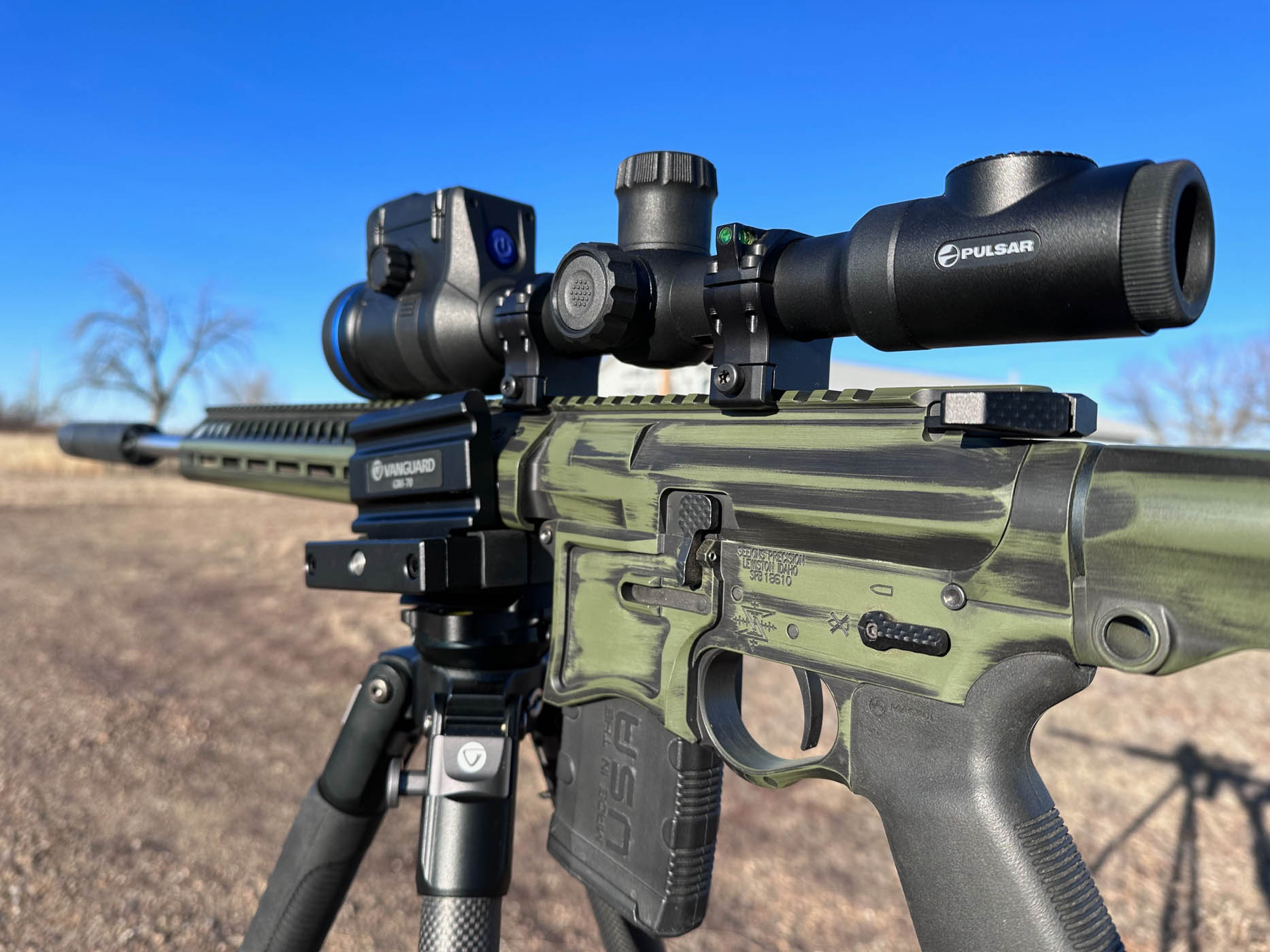
Andrew McKean
This dedicated thermal rifle scope really has it all. Its integrated laser rangefinder is fast and precise, even in extremely dark conditions. Its image capture is among the best we tested, and the sensor and display resolution are both excellent. From a strictly ergonomic perspective, it’s one of the most intuitive thermals that we’ve used, with smart button placement and functionality. Once you use the Thermion 2 a few times, you can operate the unit in full darkness.
There’s no getting around the hefty cost of this unit; it retails for right around $8,000. But it’s so laden with features and performance. It has a detection range of 2,500 yards and best-in-class germanium lens, plus an excellent integrated rangefinder that extends over 800 yards. You can consider the Thermion 2 XL50 a bridge between military-grade thermals that cost twice as much and lower-grade consumer models that cost half as much.
Among the features we appreciated the most, especially as Fossum and I toggled back and forth between different thermals over the course of our field test, are the Thermion’s wide field of view, its ability to integrate custom ballistics into its aiming solutions, and its easy connectivity with the company’s excellent Stream Vision 2 mobile app. Video recording and sharing were also noteworthy.
Sighting-in was fairly straightforward, though the menu can be a little quirky. The Stream Vision 2 app is one of the best on the market, and even has a news feed in addition to its device support.

The unit was adequate as a daytime device, but the resolution that is so sharp at night appeared washed-out in the daylight. The Thermion ships with two batteries, a rechargeable internal battery and a rechargeable external battery. Cold weather zaps nearly all thermal scope batteries, but we found that if we kept the external battery in an interior pocket, we could get good run times. But if either battery got extremely cold, run time was a fraction of the stated duration.
The rangefinder is a game-changer. Having the ability to range a target while sighting through the scope eliminates the need for a partner to do the ranging for the shooter, and it enables shooters to apply ethics to hunting situations. Is that target too far to make a killing shot? Is that “coyote” at 100 yards really a coyote, or is it instead a larger wolf, or a smaller domestic dog? Knowing the precise range to the target can help shooters better assess the size and identity of the target than they can without a rangefinder.
Given the relatively high sensor resolution (1024×768), the Thermion 2 can be considered a next-generation thermal compared with its peers, which generally have 384×288 or 640×480 resolution. In other words, it’s a thermal sight that should remain on the leading edge of fast-moving technology for the next few years.
Best Large-Caliber Thermal Rifle Scope: Trijicon REAP-IR 60
Score Card
- Ease of Set-Up: Good
- Connectivity: Fair
- Thermal Performance: Very Good
- Shootability: Good
- Field-Worthiness: Very Good
- Price/Value: Fair
Key Features
- 640×480 thermal sensor
- 12-micron image sensor
- Huge 60mm germanium objective lens
- 3x magnification with 8x digital zoom
- Five reticle choices
- Rugged aluminum housing
Pros
- Made in USA
- Thumbstick control
- Big and tactile image focus ring
- Versatile Q-LOC integrated mounting hardware
- Useful light-blocking eye guard
- Extremely rugged
- Ships in premium hard case
Cons
- At about $9,700, pricey
- Thumbstick operation takes some practice
- No Wi-Fi or Bluetooth connectivity
- Hard to download images
The 60mm REAP-IR is just one of a trio of similar REAP models from Trijicon. While they share most internal components and specs, the 60mm version costs about $2,000 more than the 24mm, and nearly $1,000 more than the 35mm model. That should give you an idea of how pricey the temperature-differentiating lens element, germanium, costs to procure and shape. The 60mm has a manual objective focus; the other units have fixed focus.
All of the Trijicons are battle-tested, durable units built to take a pounding. The aluminum chassis is tough and heavy; the 60mm model weighs about 2.5 pounds. That burly build is an indication of the REAP’s military DNA. So is the Trijicon’s Q-LOC mount and bullet-proof battery compartment — the unit takes two CR123 cells, which in our experience tend to do better in cold weather than rechargeable batteries. The Trijicon gave us a full four hours of run time in just about any temperature condition.
With 640×480, 12-micron sensor resolution, the REAP-IRs have fairly pedestrian thermal performance. We noted some significant ghosting of images in all the modes, but the vanadium oxide sensor seems to have a little better daylight resolution than its peers. The Trijicon’s palettes are a little limited; it has black hot and white hot and a very useful “edge detect” mode that would be especially helpful in personal-defense situations.
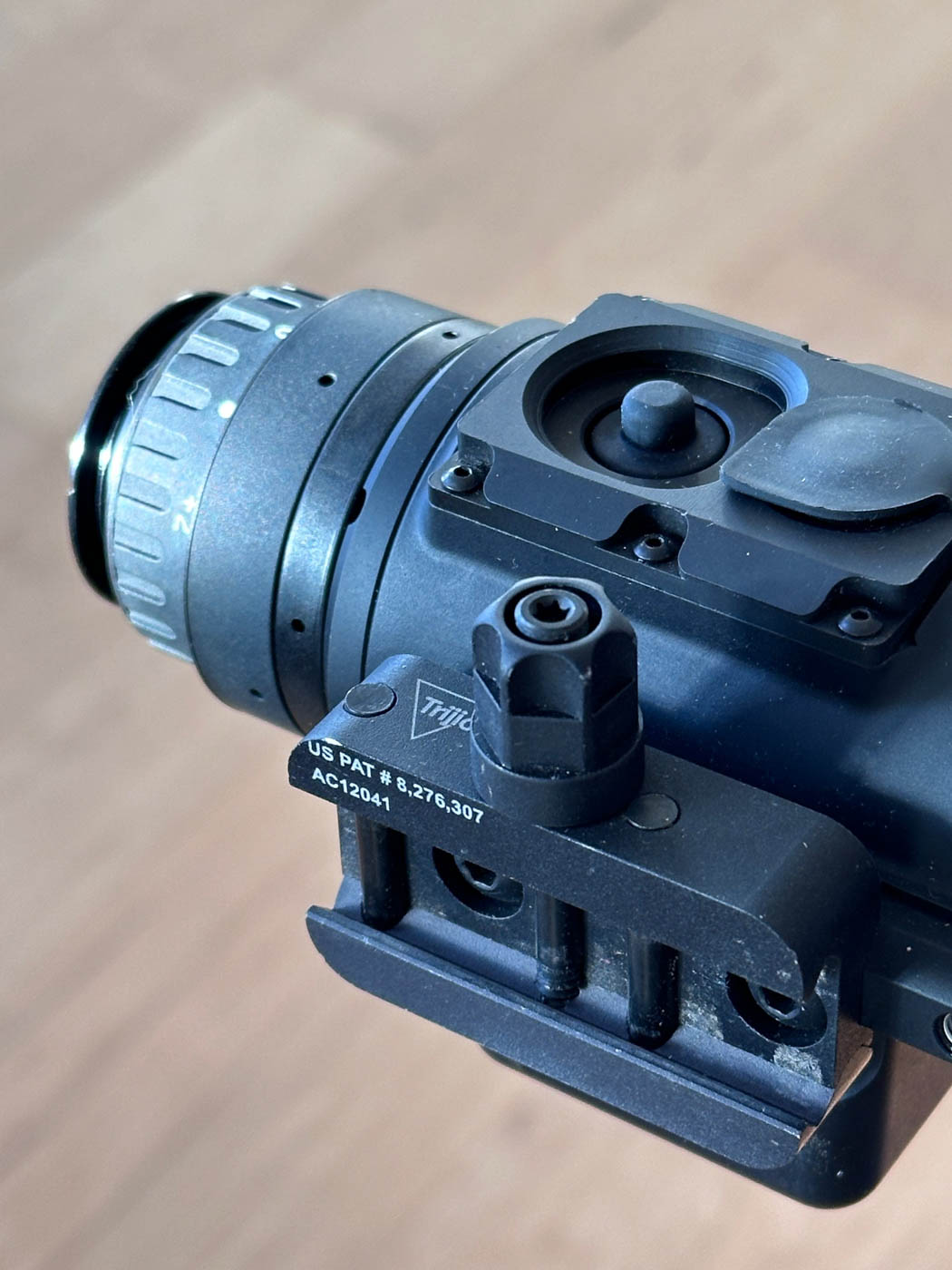
Andrew McKean
Both Fossum and I struggled with the joystick operation in our first outings, but the more I use it the more I appreciate its simplicity. Push the stick to activate the unit, then “drive” the stick in all four cardinal directions to move between modes and then pick the feature you want to manipulate. You don’t have to navigate different buttons or worry about inadvertently turning off the power or shifting between modes.
Fossum also noted a curious detail of the Trijicon. When the lens is covered during start-up, the image resolution is much improved. He also noted that covering the lens in the field, then refreshing the image, produced far better resolution than when he left the lens uncovered.
Also of note are the selectable reticles, which range from classic duplex crosshair, MRAD, and MOA, plus bullet-drop reticles tuned to .223 Rem., .308 Win., and 300 Blackout.
If you’re looking for a thermal scope that can handle the punishment of a heavy-recoiling caliber, or won’t flake out in a rut-jumping side-by-side or pickup, this is a great choice. You may be disappointed in its limited feature set, but it’s a reliable, rugged companion for just about any shooting situation.
Best Entry-Level Thermal Scope: Sightmark Wraith Mini Thermal
Score Card
- Ease of Set-Up: Good
- Connectivity: Poor
- Thermal Performance: Good
- Shootability: Good
- Field-Worthiness: Fair
- Price/Value: Very Good
Key Features
- 384×288 sensor resolution
- 1024×768 OLED display resolution
- 17 pixel pitch
- 1-8-power digital zoom
- 35mm objective lens
- 1,400-yard detection range
- Five color palettes
- 10 reticles
Pros
- At about $2,000, relatively affordable
- Easy-mounting Picatinny hardware
- Light, 19.3-ounce weight
- Easy, one-button navigation
Cons
- Only on-board video and image recording
- Relatively low thermal resolution
- No Wi-Fi or Bluetooth connectivity

If you’re looking for a dedicated thermal rifle scope that won’t cost more than your car, this very capable Sightmark is a good choice. It has some significant deficiencies compared to premium options, but with a little snooping you should be able to find this unit for under $2,000.
Among its many attributes, the Sightmark is produced by Pulsar, arguably the leading thermal brand in the U.S. The engineers and product managers know thermals, and their Lone Star constituency keeps them close to the nighttime hog hunting that’s a fertile proving ground for American thermals.
All that context has produced a capable and affordable thermal. It’s useful to know that the original Wraith was a night-vision unit, and its exterior design retains references of a helmet-mounted unit. But the Wraith thermal mounts to a weapon via a very handy Picatinny adapter, and the single-button operation makes field deployment fast and intuitive.
If there’s a downside to this unit, it’s in the field. The Wraith is an adequate thermal, but hunters who have used higher-resolution units will be disappointed in image detail and image recording capabilities. The 384×288 sensor is half the resolution of most units, and the fact that the Sightmark doesn’t connect to a mobile app limits its utility.
We found that the Wraith performed best when conditions were optimal, which in thermal operation means broadside animals inside 200 yards. The unit is certainly capable of service out to 1,000 yards, but the farther out, the more undefined images are, which means shooters need to have some additional context in order to make sure of anchoring shots at targets. In other words, out a ways, a feral hog can look a lot like your neighbor’s dog through a low-resolution thermal.
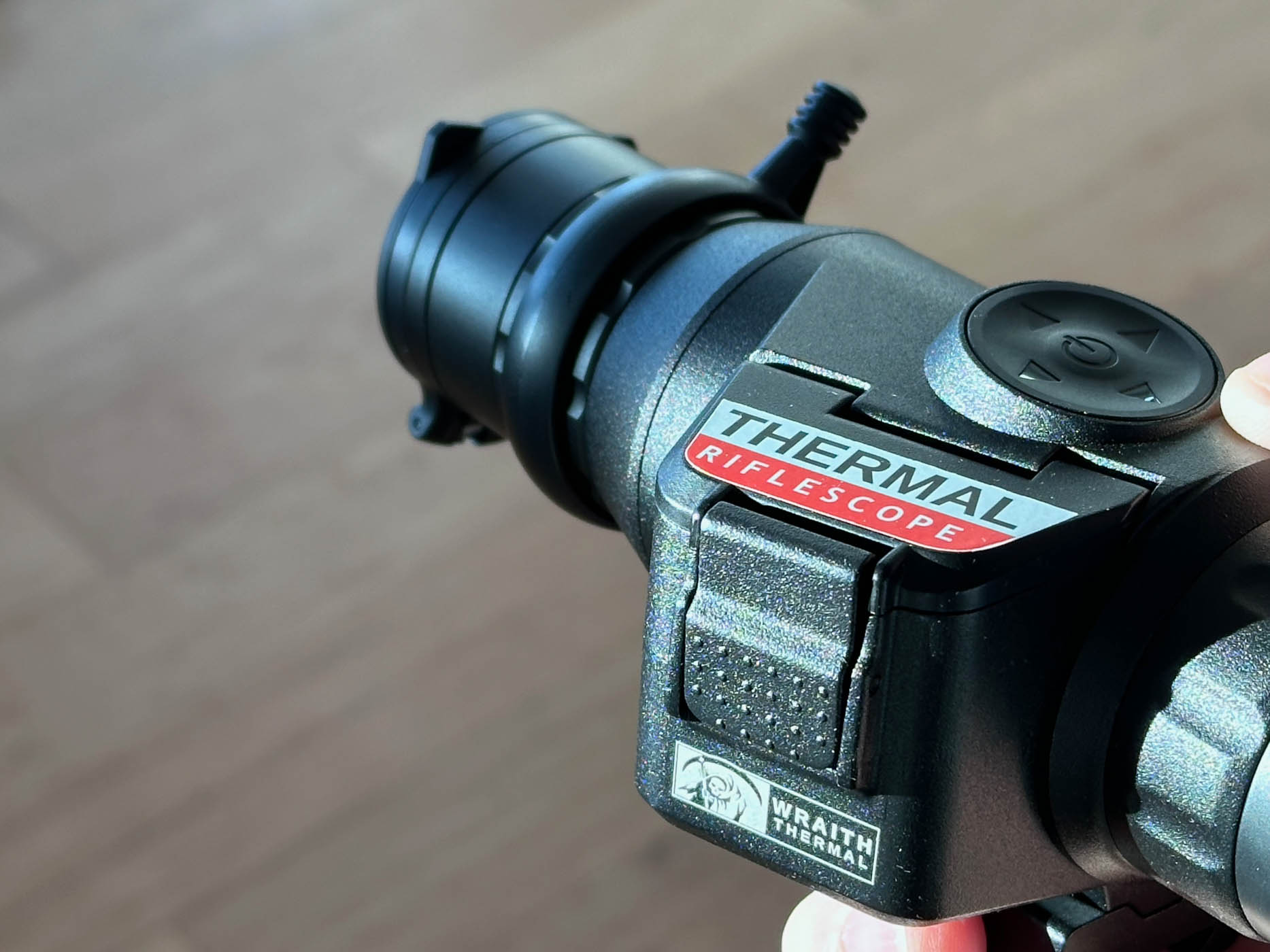
Andrew McKean
We also had a chronic problem with the battery compartment lid flying open with each shot, which we solved by taping down the spring-loaded hatch. But both Fossum and I worried that the Wraith might not be able to handle heavy-recoiling rifles as well as other thermal rifle scopes in our test.
Still, these are acceptable deficiencies for a thermal scope that costs less than $2,000. For that price, you get five color modes (white hot, black hot, green hot, magenta, and rainbow), 10 different reticles, an easy-mounting base, and enough resolution and menu options to get you in the thermal game.
Best AR Thermal Sight: Sig Echo3
Score Card
- Ease of Set-Up: Very Good
- Connectivity: Very Good
- Thermal Performance: Good
- Shootability: Very Good
- Field-Worthiness: Very Good
- Price/Value: Good
Key Features
- 320×240 thermal sensor with 12-pixel resolution
- 1-6-power x 23mm objective
- Circular 454×454 AMOLED display
- Eight color palettes
- Connects to app and tethered devices through Bluetooth and Wi-Fi
- Easily mounts via Pic-rail adapter
- Focusable lens with handy throw lever
Pros
- Easy to zero
- Connects to Sig’s BDX app and device ecosystem
- Wide angle and wide display
- Motion-activated on/off
- Housing made of tough ballistic-grade polymer
- Made in the US
- Six-hour run time on two CR123 batteries
Cons
- Not intended for long-distance shooting
- Mini-joystick controller takes some practice
Think of this as a thermal reflex sight. It basically functions as a low-magnification, wide-angle sight that’s suited for personal defense, close-range shooting at night, and pretty much any application that requires an AR.
After field testing this trim, capable unit, though, I pictured it on a close-range hog gun, a nighttime coon rifle, a straight-wall carbine, or even a shotgun. It has that kind of versatility. What it doesn’t have is a long game. While it can detect targets out to about 300 yards, it delivers fuzzy, indistinct images at that range. It’s at its best inside 100 yards, when images are crisp, fairly detailed, and display vibrant thermal signatures. Off a gun, it doubles as an adequate hand-held thermal monocular, thanks to its large display screen.
Sig actually builds two versions of its Echo3. I tested the 1-6×24 version, but there’s also a 2-12x40mm version that has a little more reach, and of course a higher price tag. The lower-power model retails for right around $2,500, about right for the combination of durability, versatility, and utility that it delivers.
Both units have sort of disappointing image resolution, which is more of a function of the low-def sensor than the better digital display. And daylight use wasn’t very effective.
Among the Echo3’s attributes are ease of sighting in. Thermal sights can sometimes be finicky and imprecise, and require toggling through pages of menus in order to get at the right combination of zero settings and reticle adjustments. Not the Sig. It’s easy, straightforward, and if you spend more than two or three shots getting zeroed, you’re probably doing something wrong. We also liked its wide, rounded display, and its ability to receive reticles from the BDX app. That app, which also powers Sig’s Wi-Fi-enabled rangefinders, syncs to the Echo3, allowing range-informed aiming solutions to be shown in the display. The BDX app also facilitates image transfer.
The joystick control is similar to that of the Trijicon and it shares a steep learning curve with that unit. But once you get the hang of it, it’s an elegant and simple way to toggle between functions.
In all, it’s a useful AR-mounted thermal that has wide utility for shooting situations inside 100 yards. Beyond that, and you may be wishing you had a little more magnification and resolution.
Pulsar Thermion 2 LRF PRO
Pulsar Thermion 2 LRF PRO
Best Overall
Key Features
- Capable of detecting heat signatures out to 2,000 yards
- Built-in laser rangefinder has a stated range of 875 yards, and effective range of about 500 yards
- 2-16-power magnification range
- Built-in photo and video recording, which can be stored on 16GB memory or streamed via on-board Wi-Fi to mobile app
- Ten digital reticles
- Nine different color palettes
Pros
- Tons of useful features
- Long detection range
- Excellent resolution and detail
- Intuitive ergonomics
Cons
- Limited inventory (currently)
- Refresh rate could be faster
In terms of products available on the civilian market, this rangefinding riflescope has the best combination of range, detection sensitivity, ease of use, and ample mounting dimensions. It’s also among the more durable units, and its combination of on-board and removable batteries is a key asset to keep it cranking in cold weather. Its data-capture-and-share capability is impressive. It has the ability to record both photos and videos, and then share to a mobile app via its built-in Wi-Fi.
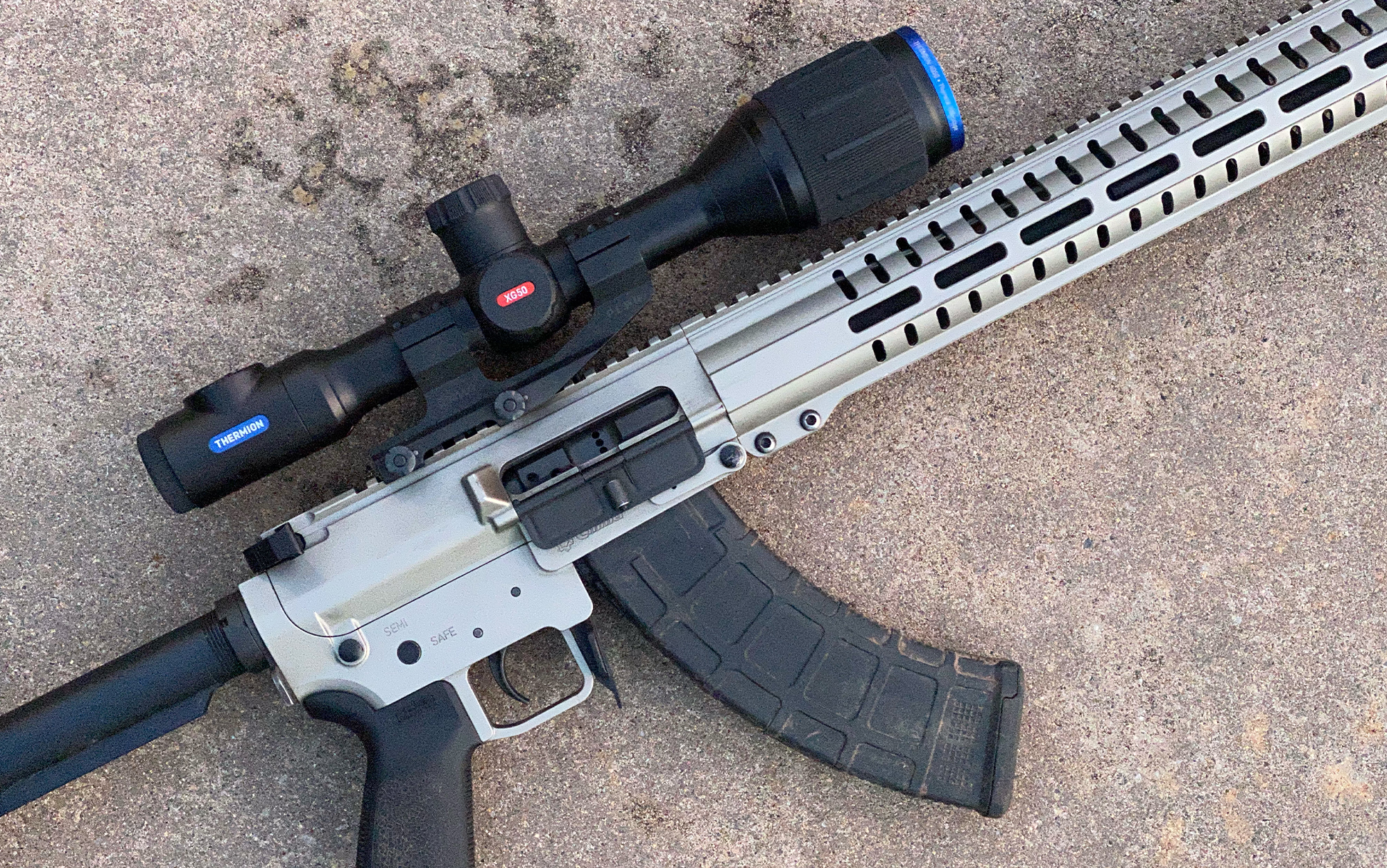
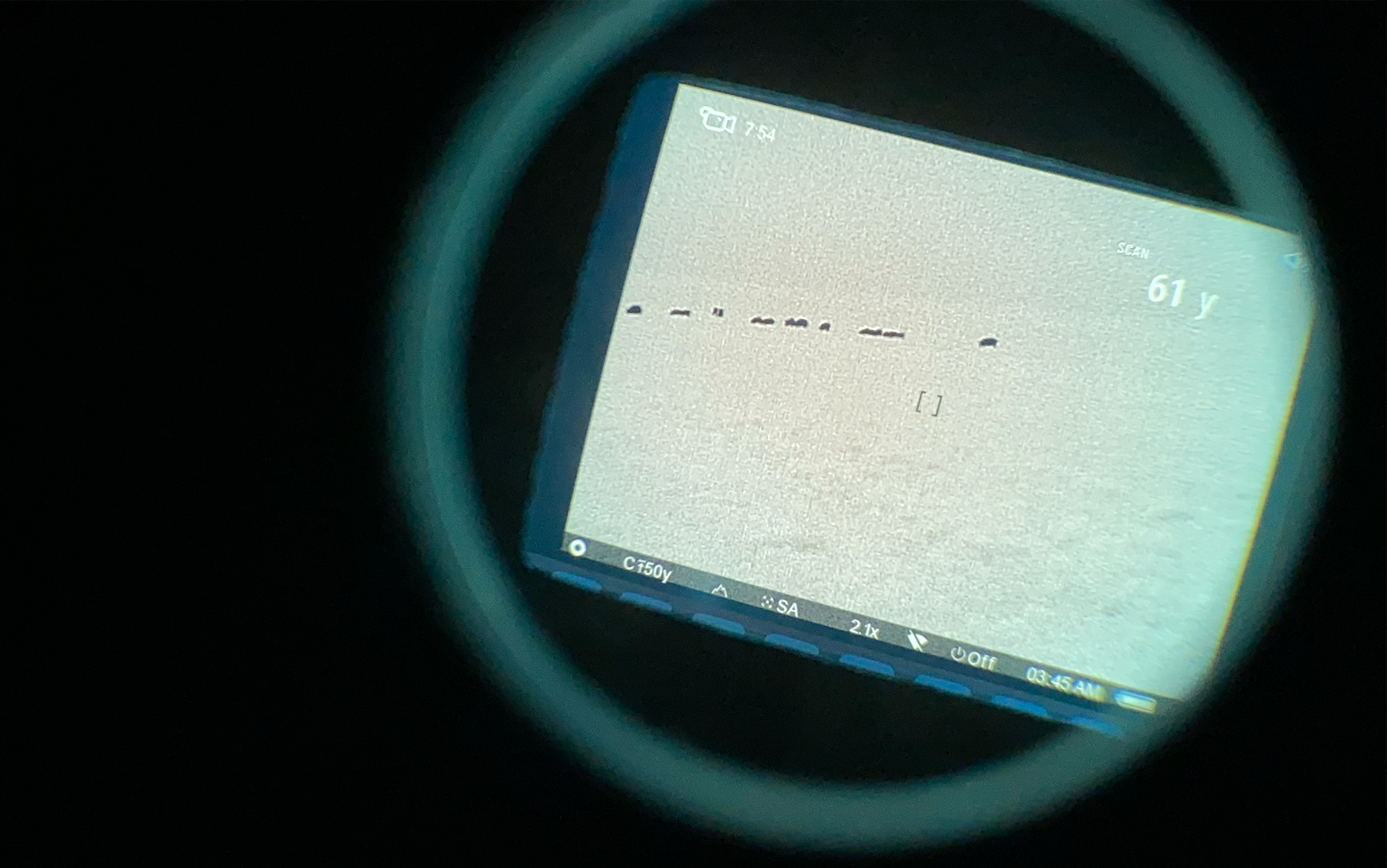
While the unit can detect heat signatures out to 2,000 yards, it only really becomes useful inside about 500 yards, when images start to gain resolution and the rangefinder — rated out to 875 yards — can identify targets quickly and with pretty good precision. The rangefinder has an inclinometer, unusual in this class of scope, and a ballistic calculator that can prescribe shooting solutions. The magnification range — 2x out to 16x — is useful, as is the ability to choose between 10 reticles and nine different color modes. For precision shooting, the “picture-in-picture” mode, which magnifies the aiming point, is a useful feature.
The ergonomics and ease of use are both excellent, starting with the ambidextrous focus control on the thermal housing near the objective bell. The three-button control pad near the eyepiece is intuitive and textured to make navigation in total darkness repeatable after a few uses.
In terms of its guts, the Thermion 2 is powered by a 640×480 microbolometer resolution sensor and a sharp 1024×768 AMOLED display that pops against just about any background.
Let’s talk about its price — over $6,500 — and its scarcity. This product hasn’t been available for a few months, and there’s a good deal of uncertainty over sourcing for a number of brands, besides Pulsar. It’s enough to suggest that instead of germanium, the material thermal manufacturers are using might as well be called unobtanium.
While much of the Thermion 2 looks and behaves like a traditional riflescope, the processor that’s mounted above the objective bell is bulky and throws off the balance. The refresh rate is better than earlier iterations of this scope, but I still wish it was a little faster. While using this scope on a Texas hog hunt, I found that it froze at the most inopportune moments, a situation that’s easy to resolve with manual refresh.
Best Clip-Ons: Reviews & Recommendations
Most readers are familiar with traditional glass-and-metal rifle scopes. You look through them, use the internal reticle as an aiming point, and make adjustments with windage and elevation turrets. Thermal rifle scopes, which we discussed above, function much the same way, only they use a digital screen to display the world rather than delivering targets through image-magnifying glass. But there’s another category of thermal sights: clip-on models. These attach to the front of your traditional rifle scope, converting it into a thermal unit.
The advantage of clip-ons is that you can still use one of the best rifle scopes, and magnification, parallax, and turret manipulations all still control your aiming point. Most clip-ons attach to the objective bell with an adapter ring, and when you’re done hunting at night, simply detach the thermal and you’re back to your day optic. Clip-on thermals have lower magnification (often one-power) than dedicated thermal rifle scopes, because they use the magnification of the attached scope. And because they don’t have reticles of their own, or turrets, they’re more basic — and therefore generally less expensive — and simpler to use.
The downside of these clip-ons is that they don’t have large screens, and they generally are difficult to use when removed from a scope. But in that way, they’re not so different from dedicated thermal riflescopes, which also have a singular purpose.
Best Clip-On: Liemke LUCHS-1
Score Card
- Ease of Set-Up: Excellent
- Connectivity: Good
- Thermal Performance: Excellent
- Shootability: Very Good
- Field-Worthiness: Very Good
- Price/Value: Good
Key Features
- 640×512, 12-micron thermal sensor
- Nearly 2,000-yard detection range
- 1024×768 OLED color display
- 32 GB on-board memory
- Wi-Fi-enabled
- “Sun” and “rain” image modes boost contrast
- Connects to mobile app
- At 2x, image completely fills scope image
- Five color modes
Pros
- Three-position power switch easy to activate
- Intuitive three-button operation
- Short length easy to reach on front of scope
- Nine-hour run time
- Can be used as clip-on sight or hand-held monocular
Cons
- 50 Hz refresh rate slightly slower than peers
- At about $5,500, it’s pricey
Because they’re not constrained by wildlife laws prohibiting nighttime hunting of game animals, Germans and Austrians pioneered technology to enable low-light hunting success. Think of those traditional European rifle scopes with giant objective lenses and extremely subtle reticle illumination.
European hunters have been similarly early adopters of thermal technology, so it’s no surprise that some of the most capable thermals are being produced by European optics brands. This Liemke clip-on is the latest evolution in game-getting technology. It’s rugged, powerful, smart, versatile, and expensive. The consortium of leading brands that includes Mauser, Blaser, and Sig Sauer recently bought Liemke in order to bring thermal products into their house, and the excellent LUCHS-1 clip-on sight is the result.

Since the LUCHS-1 launched last year, Liemke has introduced its more powerful LUCHS-2 but also a more affordable and shorter-range LUCHS-25.1, which has a detection range of about 1,000 yards and retails for around $2,600.
The value proposition of clip-ons, as detailed in the intro, is that they enhance the capability of a traditional rifle scope. I paired the LUCHS-1 with a very good Blaser B2 2-12×50 scope, transforming a clean and clear traditional optic into a powerful and equally clear thermal scope. Nighttime use is enabled by a couple of smart features, including the large and positive three-position power lever with on, standby, and off positions, as well as an intuitive three-button arrangement that enables fast and sure operation in the field.
At 2x, the Liemke delivers a digital image that matches the eye box of the rifle scope. That’s an important consideration, since the image of many clip-ons appears as a small, square digital image in the scope, limiting field of view and situational awareness. At 2x, the Liemke has a 22-meter field of view at 100 meters. That’s wide.
Among its other attributes, the LUCHS was easy to zero, and its two image modes, “sun” and “rain” can be used to sharpen images, depending on light and fog conditions. The Liemke’s daytime and nighttime resolution are among the best in the field, though not quite as good as the Leica clip-on beyond about 1,000 yards. With 32 gigs of on-board memory, there’s plenty of capacity to store videos. You can transfer images and videos either via the Liemke mobile app or to a device via a USB-C cable.
Liemke claims the LUCHS-1 can work as either a clip-on or a hand-held monocular, but our observations are that it’s far better as a rifle sight. As a monocular, the display remains fairly small. But when enhanced by the scope’s magnification, the thermal image is sharp, suitably large, and so detailed we could see fine textures in coyotes’ pelts out to about 250 yards.
Best Image: Leica Calonox Sight
Score Card
- Ease of Set-Up: Excellent
- Connectivity: Very Good
- Thermal Performance: Very Good
- Shootability: Very Good
- Field-Worthiness: Good
- Price/Value: Good
Key Features
- 384×288-pixel thermal sensor resolution
- 1024×768-pixel OLED display resolution
- 17 um pixel size
- 1x42mm focal length
- 2,187-yard detection range
- 766-yard recognition range
- 383-yard identification range
- Bluetooth connectivity to mobile app
Pros
- Excellent resolution
- Threaded for tripod adapter
- User-friendly, intuitive three-button menu
- Excellent day and night modes
- Leica Image Optimization processor sharpens images
Cons
- 50 Hz refresh rate slightly slower than peers
- Use as thermal camera is underwhelming
- No color palettes
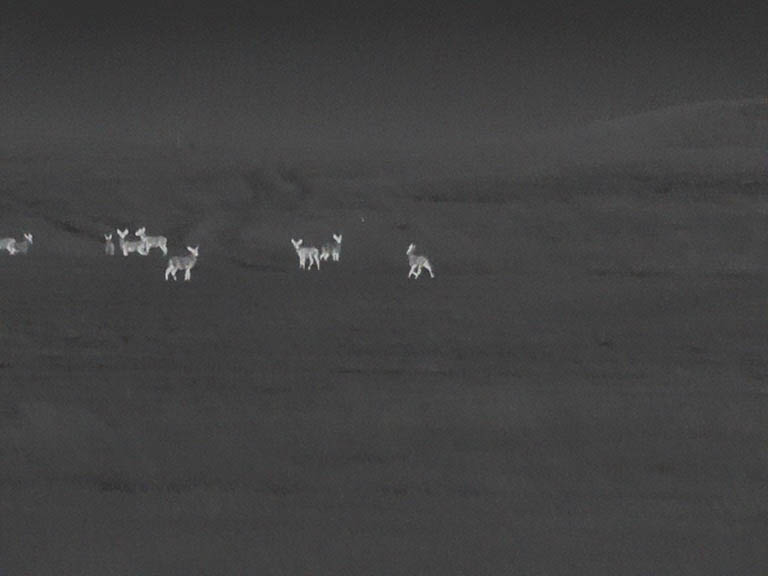
Leica’s long experience building premium cameras gives this clip-on thermal an edge in terms of image processing and overall build. The Calonox has the durability, tightness, and responsiveness of a high-end camera, and the thermal images it delivers are far better than its fairly modest sensor resolution would suggest. Both Fossum and I saw this at medium to longer ranges; the Leica was sharper, delivered more contrast, and allowed for target identification at longer ranges than any other thermal in our roundup.
It’s worth noting that the Calonox clip-on has a fraternal twin. It’s Leica’s Calonox View, a hand-held thermal monocular that has the same feature set as the clip-on, but is designed to function in hand, instead of strapped to a riflescope. Together, they’re an impressive duo, giving users the ability to scan with the monocular, detect and identify a target, and then get behind the rifle to make a shot through the clip-on.
The price, around $4,100, for the clip-on thermal is pricey, but justifiable considering its talents. Leica’s Calonox Sight SE, which lacks a Bluetooth transmitter and has less range than its big brother, retails for about $3,100.
The Calonox operates with an intuitive three-button design that is easy to learn and then deploy in the field. The unit is short enough that shooters can easily reach the controls from a mounted position, and battery life was one of the longest in our collection. Image transfer is a cinch through Leica’s excellent Calonox Sight App, though users should note that there’s no on-board image storage. The app allows users to change menu settings and display options through their phone.
We found the refresh rate to be slightly sluggish, meaning sometimes we had to wait for the image to unfreeze before we made a shot. And getting the clip-on to mount just right to a scope — you want the distance between the objective lens of the scope and the eyepiece of the thermal to be precisely spaced in order to ensure alignment and focus — can be tedious, though the app has a useful tutorial to guide you.
In all, the Calonox is a wonderful, extremely useful, piece of technology, and already Leica has announced updates for this year. Given that, it might be worth looking for discounts on the excellent old-school Calonox.
Best Value Clip On: AGM Rattler TC35-384 Thermal Clip-On
Key Features
- Weight: 0.93 pounds
- Magnification: 1x (2x,4x,8x digital)
- Resolution: 384 x 288
- OLED Display: 748 x 561
- Objective Lens Diameter: 35mm
- Detection Range: 1,235 Yards
- Frame Rate: 50 Hz
- Pixel Pitch: 17 um
- Waterproof and Shockproof: IP67 Rating
- External Power Supply Capable
- 4.5 Hour Runtime on CR123 batteries
- 16 GB Storage for Videos and Pictures
Pros
- Good battery life and can run on an external battery pack
- Can be moved from rifle to rifle
- Allows the user to use their day scope’s turrets for longer shots
- Records video and images
Cons
- No sound recording with video
- It takes about 3 seconds to get a video recording started
The AGM Rattler TC-35 is the best value thermal clip on for a few important reasons: digital zoom, external battery compatibility, and video recording.
The biggest standout is its digital 2x, 4x, and 8x zoom. This makes it quite useful as a handheld monocular. If you want to use it as a dedicated monocular, I’d pick up the optional eye piece for about $300. The eyepiece makes the image appear larger to your eye while using it as a monocular. Even without the eye piece, it’s a serviceable monocular when it’s not on your gun.
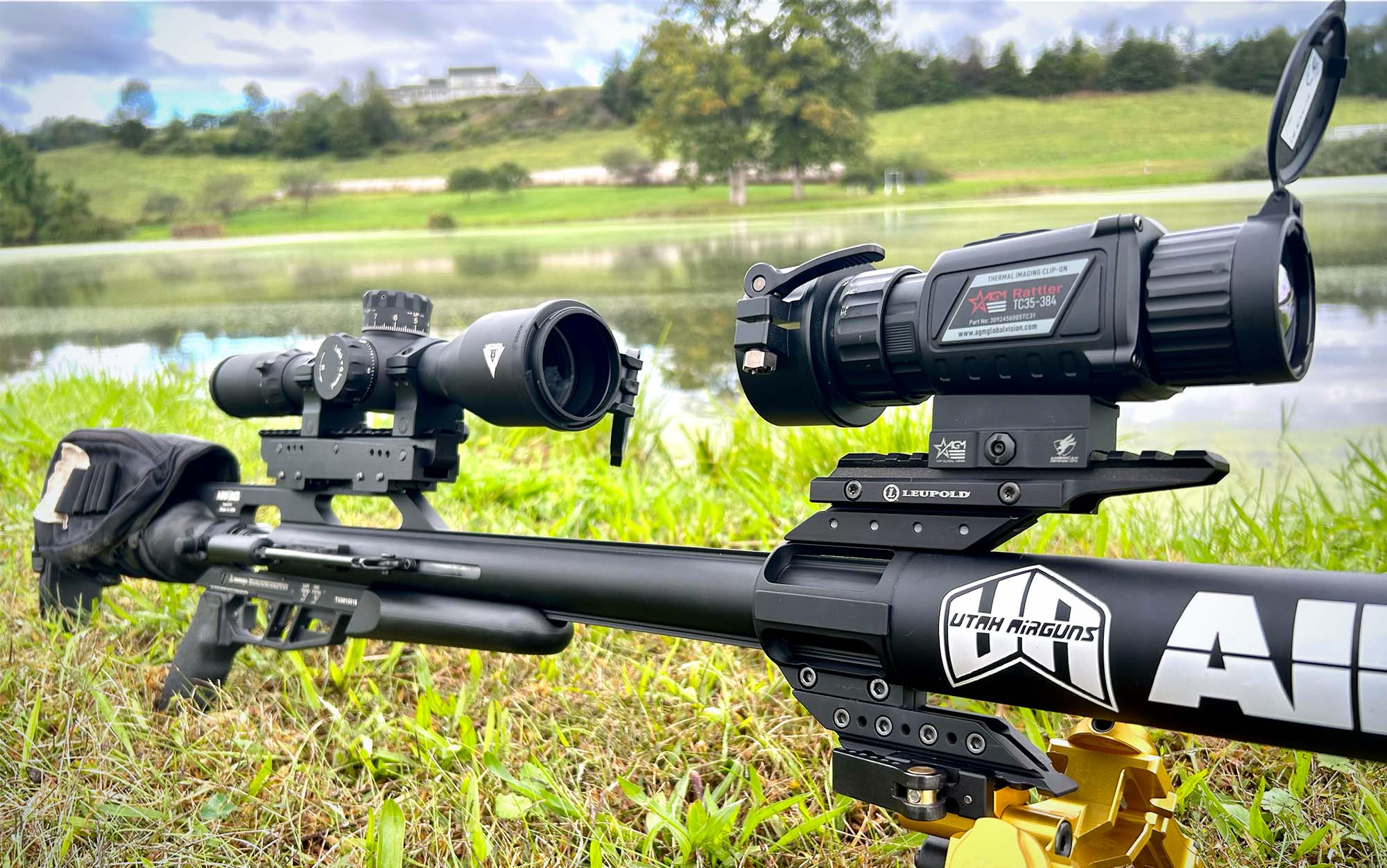
The Rattler has external battery capability. This is a huge plus if you want to hunt for more than 4 hours or hunt in extreme weather. Freezing temperatures will kill a normal CR123 battery quickly, but an external battery pack rated for 20 hours will let you hunt without worrying about battery life. External batteries are also easy to wrap a hand warmer around, extending operating time greatly.
The rattler records video and takes photos. It boasts 16 GB of onboard storage, which is plenty to get you through even the most active hunts. Be aware that there is no microphone, so the recordings have no sound. To get around this, I purchased a cheap audio recorder the size of a pack of gum for when I want the audio. Unless you are a YouTuber like me, you probably won’t care much about the audio, but it is worth noting. My only real complaint with the video function is that it requires a long press of 3 to 4 seconds to start. That can feel like a long time when a coyote is passing through.

One thing to remember when using this unit or any other clip-on is that less magnification on your day scope is better. Low magnification lets you see more of the OLED display. More magnification is helpful for longer shots but restricts your field of view. For this reason, I like a second-focal plane scope with low magnification and illuminated reticle. I find the sweet spot to be around 5x magnification when using clip-ons.
My Rattler is incredibly repeatable when taking it on and off of the rifle, holding within 1 inch of zero at 100 yards. I have also found that when attaching it to the scope bell, it can be used on scopes of the same brand and model without re-zeroing the thermal unit. That’s why I own multiple rifles with the same brand and model scope on them. This allows me to choose which rifle is best for the task at hand, whether it be an AR-10, bolt gun, or airgun all without touching the clip-on’s settings.
At about $2700, this optic packs in a ton of features and is a great option for owning the night.—Keith Gibson
Read Next: Best Night Vision Scopes
New Thermal Scopes for 2024
I combed the SHOT Show floor checking out the latest in thermal scopes, and there are a lot of exciting optics coming out this year. We’ll be testing as many thermal optics as possible this year so keep an eye out for our full reviews on the options below. —Scott Einsmann, gear editor
InfiRay Rico HD
Highlights
- 1280×1024 sensor resolution
- 1.3 million pixels
- 2560×2560 display
- 2X optical magnification
- 16X digital magnification
- 3,600-yard detection range
- MSRP: $16,000
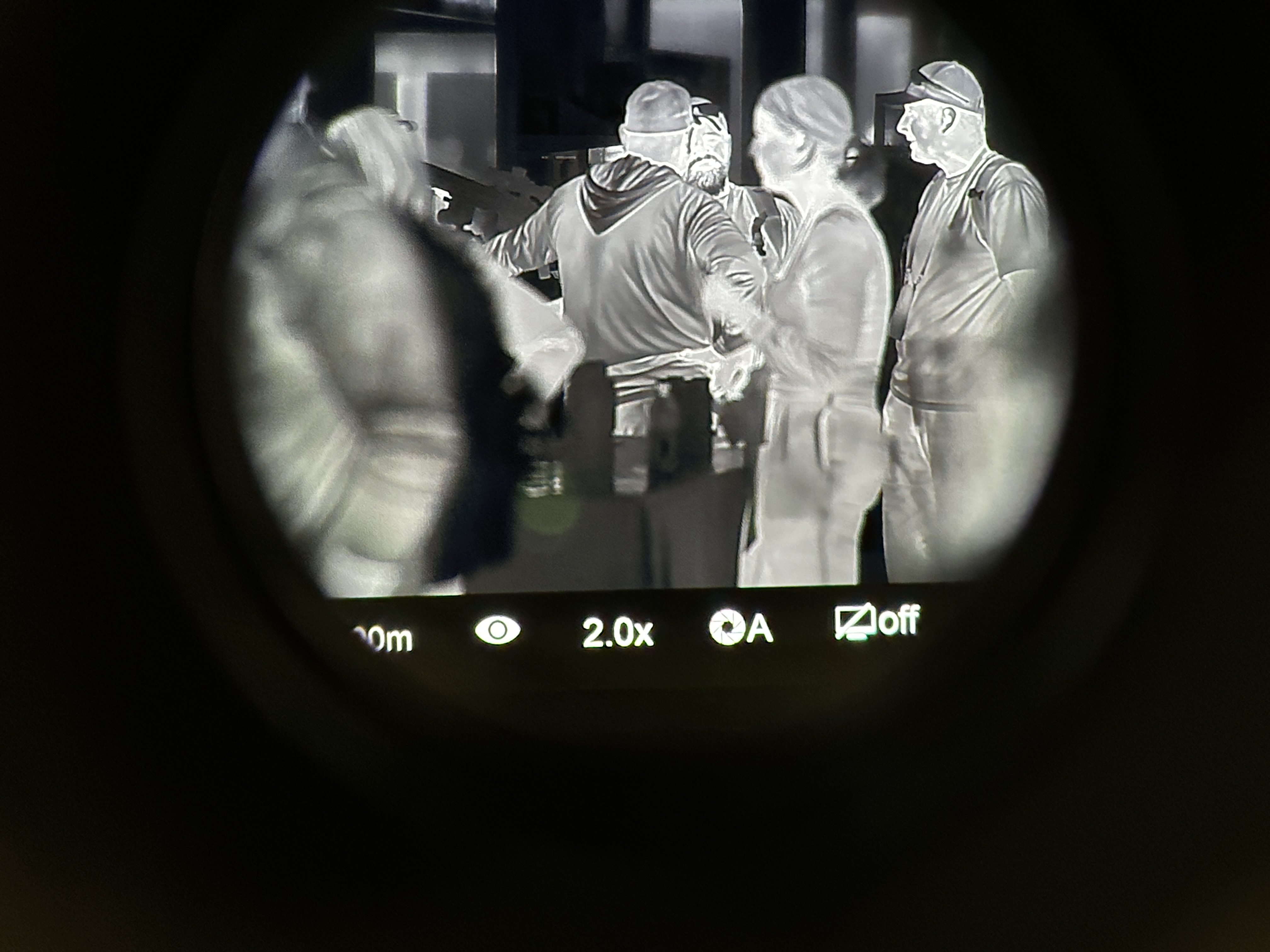
The Rico HD represents the cutting edge of thermal technology. Consider that the industry standard for a high-quality thermal is a unit with a 640×512 sensor resolution; The Rico HD has more than double that resolution. This detail means you’ll be able to identify animals at long distances and zoom in tight while maintaining a clear sight picture. Of course, that crisp image and versatility will cost you plenty; these will be available to purchase for $16,000 within a month.
AGM Rattler V2
Highlights
- Sensors from 384×288 to 640×512
- 2560×2560 display
- 1,800 to 2,600-yard detection range
- MSRP: $2,095 to $4,495

AGM’s popular Rattler line of scopes and clip ons are getting updated for 2024. They’ll have improved detection range, faster refresh rate, and more battery life. Just like the original Rattler line, they’ll be available in a range of price points, magnifications, and resolutions. The Rattler V2 scopes are available for purchase right now and the clip-on sights will be available later this year.
Holosun DRS
Highlights
- Thermal Overlay
- Magnification: 1x
- Refresh Rate: 50 Hz
- Resolution: 256×192 pixels
- Battery Type: 18350
- Battery Life: 12 hours
- Water Resistance: IP67
- Weight: 18.5 oz
- MSRP: $1,600
The Holosun DRS-TH is a uniquely compact optic that’s designed for fast shooting at close ranges. It has features you’d expect to find on modern thermal scopes like video recording, rechargeable batteries, different color palettes, and reticle options. I got hands-on with the Holosun DRS-TH at SHOT Show’s range day and found the resolution to be good at the close ranges the optic was designed for.

It’s important to note that I shot the above video with the scope cap closed to show what the optic looks like at night. With the scope cap up, looking through the DRS was like any red dot sight — a reticle overlaid on clean glass. I wasn’t able to see how the optic performed on heated targets, but I will be doing a full test and review of the DRS when they become available next month. One of the best things about the Holosun DRS-TH is its price. It’s very affordable compared to competitive offerings like the Sig Sauer Echo 3 and X-Vision XVT.
InfiRay Rico Hybrid
Highlights
- 640×512 sensor resolution
- 3X or 4X optical magnification
- 8X digital magnification
- Detection Range: 2,400 yards (3X) or 4,200 yards (4X)
- Onboard ballistic solver and BDC reticle
- Works as a scope or clip-on
- 2560×1920 display
- MSRP: $7,000 (3X) or $8,000 (4X)

Thermal scopes are expensive and the sting is lessened when they’re versatile. The Rico Hybrid is a high-end scope that’s also a clip-on sight. So you could use it on a dedicated night setup or you can move it from rifle to rifle. It could also work as a monocular if you were so inclined. The Rico Hybrid doesn’t have a built-in rangefinder, but it is compatible with InfiRay’s ILR-1000-2, which costs $800. If you use it with the rangefinder, the scope provides ballistic solutions for easy shooting at long ranges. One of the best features is the 4X base magnification, which means you’re starting at a higher optical zoom and you’ll retain better image quality as you zoom in farther. The 4X version is shipping out to dealers soon and the 3X is already available for purchase.
Things to Consider Before Buying a Thermal Scope
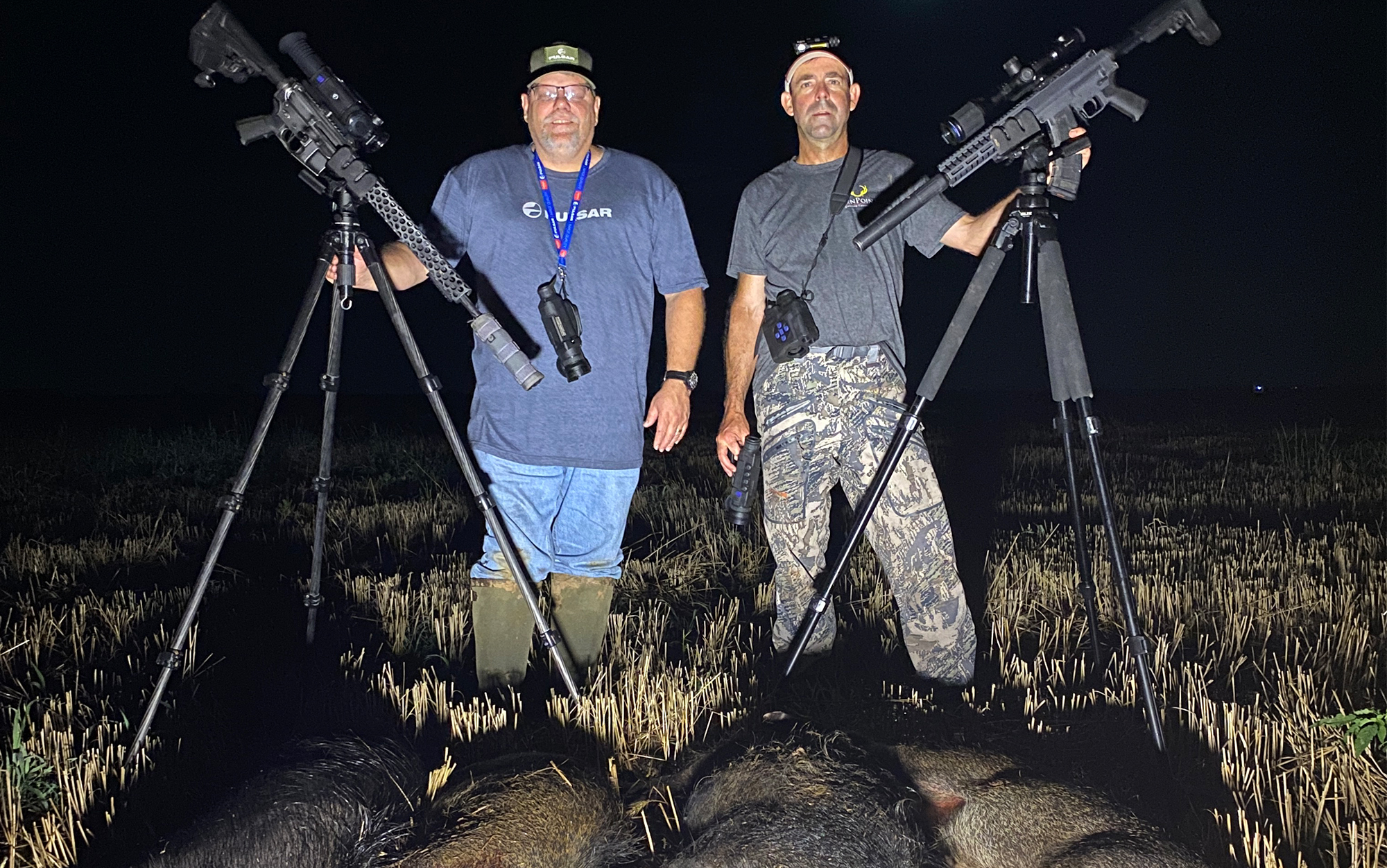
The first thing you should consider if you’re in the market for one of the best thermal scopes is how you’ll use it. Do you want a rifle-mounted scope, with reticle and even a built-in laser rangefinder? If that’s the case, then you’re looking at a fairly expensive subset of thermals. Or maybe you just want a unit to see into the night. A hand-held thermal will do just fine, at a fraction of the cost of the thermal scopes, but without any ability to place after-hour shots.
Second, consider your budget. You can spend anywhere from about $1,000 to well over $10,000 on these devices. But if you’re simply interested in a viewer to detect animals or maybe a car parked at a trailhead, you won’t need all the bells and whistles of a scope. But if you want a plug-and-play scope to shoot coyotes or varmints after legal shooting light, then you should expect to pay well over $3,000 for the most capable rifle-mounted sights.
FAQs
Thermal units range in price from around $1,000 for basic thermal viewers to over $7,000 for the most sophisticated rangefinding scopes. Keep in mind that these aren’t night-vision units, which can cost only a few hundred dollars. Thermal scopes depend on a rare-earth element called germanium, which supplies temperature-sensitive glass for thermal units. Generally speaking, the best combination of attributes, capability, and overall utility of thermal units will set you back around $3,000.
That’s a great question. You’ll generally see a couple of different resolution equations mentioned for thermal devices. One measures the sensitivity of the sensor, or the interface that receives the thermal image. The bigger the numbers, the more detail the sensor is receiving. That’s generally a function of quality components and size of the objective lens. For higher-quality units, look for sensor resolution of about 640×480 pixels. You also want to pay attention to the display sensitivity. That’s a measurement of how much detail you’ll see on the screen of the device. The higher the number, the more contrast and detail you’ll observe. Resolution of 1064×748 provides very good visibility.
There are a number of quality brands on the market, but generally European brands only have thermal sights or what are called clip-on units, intended to be used with a standard riflescope. Units from Russia and Southeastern Europe generally have a good combination of rangefinding riflescopes and hand-helds, though quality is variable. Then there are American brands such as Trijicon and Burris that have consumer versions of their military-grade thermals.
Generally, thermal scopes and viewers are illegal to use in pursuit of game animals, like deer or turkeys. But most states allow their use for non-game animals, like coyotes or raccoons. You’ll have to check with your state’s hunting regulations to see if they’re expressly prohibited. Because they occupy a gray area, it’s a good idea to also check with your local game warden.
Final Thoughts on the Best Thermal Scopes
The best thermal scopes and clip ons are getting more affordable and accessible by the day. Until you are able to see through the darkness and pick up thermal signatures several hundred yards out in the field, you might not think you need one of these devices. But once they reveal all the hidden secrets of the night, you’ll want one just to see what happens around you in the dark.
But not all thermals are created equally. Generally speaking, you get what you pay for, with the cheaper units lacking some crucial attributes, but the most expensive having more modes and capabilities than most people normally need.
- Best Scopes
- Best Overall: Pulsar Thermion 2 LRF XL50
- Best Large-Caliber Thermal Rifle Scope: Trijicon REAP-IR 60
- Best Entry-Level Thermal Scope: Sightmark Wraith Mini Thermal
- Best AR Thermal Sight: Sig Echo3
- Best Clip Ons
- Best Clip-On: Liemke Luchs-1
- Best Image: Leica Calonox Sight
- Best Value Clip On: AGM Rattler TC35-384 Thermal Clip-On
